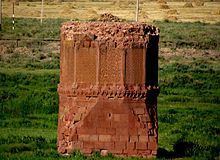Type Mausoleum | Beginning date 12th or 13th century | |
 | ||
Similar Barda Mausoleum, Garabaghlar Mausoleum, Mausoleum of Sheikh Juneyd, Mammadbayli Mausoleum, Momine Khatun Mausoleum | ||
Ancient Gulustan Mausoleum (Azerbaijani: Gülüstan türbəsi) – is one of the significant monuments of Nakhchivan. It is a pearl of the stone arts of Azerbaijan.
The mausoleums of Nakhichevan was nominated for List of World Heritage Sites, UNESCO in 1998 by Gulnara Mehmandarova — president of Azerbaijan Committee of ICOMOS—International Council on Monuments and Sites .
Architecture
The mausoleum was built in the 12th-13th centuries. Gulustan means "heavenly garden", because the mausoleum is located in a green hollow, not far from the Aras River and this place is called rose garden.
The mausoleum was built of red sandstone. This construction has 12 facets and was covered with rich and complex, but immensely fine geometric ornaments.
The mausoleum stands on a great pedestal which looks like dressed triangle feathers. Once, the mausoleum was crowned with a pyramid-cupola. It hasn’t remained up to this days, but all remaining parts are preserved perfectly.
All sides of the mausoleum were decorated with ornaments and inscriptions. Upper part of the mausoleum was decorated with ornamental nettings. There is an aperture leading to the mausoleum in the northern part. It leads to the underground part of the mausoleum. It is poorly illuminated by small windows like loopholes. Inner part of the mausoleum hasn’t any ornamentation.
